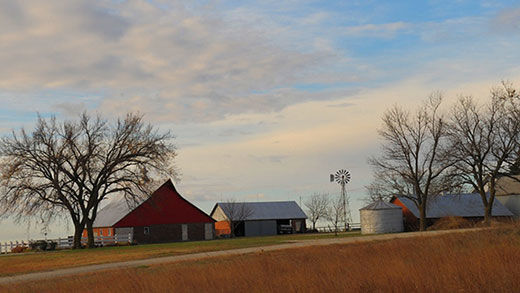2019 Kansas farm income summary and projections continue to paint a bleak picture
As Kansas farmers are about to begin summer activities they face a tougher 2020 than what they experienced in 2019.
During a recent webinar from the Kansas Farm Management Association at Kansas State University, Director Kevin Herbel said the 2019 farm income from its 2,000 farm families indicated an average farm income of $110,380, which was 9% higher than 2018 figures. However, he noted the top quarter averaged $330,000 but the bottom quarter experienced a $49,000 loss and 18% of farms showed a loss in 2019. It also varied by region as southcentral Kansas and southeast Kansas had income drops of $30,000 and $25,000, respectively.
Economists noted the Market Facilitation Program payments, which came about as a result of U.S. Department of Agriculture tranche to offset losses from a trade war with China. The subsidy added about $60,000 on average to KFMA participants, was crucial to their bottom lines.
Without those payments, farm income would have been about $49,963, said Mark Dikeman, associate director of KFMA. “MFP had a very big impact on farm income.”
The average farm in the KFMA is about 2,500 acres with 1,700 acres in crop ground. Larger farms are found in western Kansas. Farmers are also finding that as 2019 came to close, the squeeze in cash flow meant producers were adding debt to help finance their operations. Earlier in the decade they added acreages to their operation and also tended to add more debt to purchase equipment to cover those acres.
“The best farms have been able to keep themselves in a strong working capital position,” Herbel said was what economists found was the best way to ensure long-term success.
Gregg Ibendahl, associate professor in the department of agricultural economics at K-State, said as he tries to project 2020 net farm income, the coronavirus will have an impact but was not the only driver because it was no factor in the first two months of the year. He also noted that wheat yields in 2019 were much higher in many cases compared to expectations so he had to take that into account in his projections.
Livestock industry feeling impact
Livestock will take a big hit, he said. All livestock sectors are bracing for a 20% lower in revenue from beef and swine side, Ibendhahl said. Some regions will vary depending on their level of operation but all will take a hit. In Iowa, economists believe swine will take about a 30% hit.
In 2020, lower corn prices will mean about 16% lower in revenues, grain sorghum will be about 5% lower, soybeans about 11% lower and wheat about 8% lower. The projected wheat price is similar to 2019 but he readjusted the revenue figure downward because yields were much higher in 2019 in compared with forecasts in 2020.
In 2020 crop insurance programs will help KFMA members as the signup occurred this winter. The Price Loss Coverage program will provide help to grain producers—wheat at an estimated 88 cents a bushel, sorghum at 77 cents a bushel and corn 7 cents a bushel.
“It pays to have a good crop base,” Ibendahl said.
One positive he found was that important expenses could be lower, including for anhydrous ammonia and diesel fuel. Because farmers often buy in advance they will only reap a partial saving, but those lower prices might be something that could carry into the 2021 season.
Ibendahl said the average interest rate was 4.5%. In 2019 farmers added 4% more in debt to their balance sheet and he was projecting an additional 4% in 2020.
Livestock farms will see some of the biggest hits to their bottom lines. It’s not looking very good at all for the livestock farms.
“There is monies, $16 billion, available to help alleviate some of the bleak picture that I painted earlier,” Ibendahl said.
Glynn Tonsor, professor and Extension specialist at K-State who studies livestock and meat marketing, said the story changes by the day because of the pandemic.
In Kansas, he believes the COVID-19 will make for a $1.6 billion combined bottom line hit on the cattle and swine markets compared to non-pandemic impact.
If you sold steers in a feedlot before April 15 the producer might be able to secure a $214 head payment. However, most producers will not see that. “We will have a large negative effect,” Tonsor said, regardless of the size of the government program.
How money will be used
Ibendahl said farmers will use the payments for living expenses and some may use it for an asset purchase. Tonsor said livestock producers have traditionally rejected government participation but are realistic in supporting a program. Some producers will use monies to stay solvent and for others the government payments may lead to higher pasture rents, since producers would have more money available to bid up rents.
Dikeman said in 2019 moisture was the primary factor in the farm income story, both positive and negative. Northwest and western parts of northcentral Kansas had strong dryland fall crops that boosted bottom lines. Plus those regions and in southwest Kansas had impressive wheat yields to boost revenue, but in portions of eastern and southcentral Kansas excessive moisture caused problems. In addition, livestock producers had muddy winter conditions that caused significant losses.
Moisture also boosted portions of the hay industry but hurt some forages. Excessive moisture meant about an additional 2.5% in prevented planted acres. A wet and cold winter also caused significant problems for livestock producers as death losses increased because of muddy conditions.
Dave Bergmeier can be reached at 620-227-1822 or [email protected].

